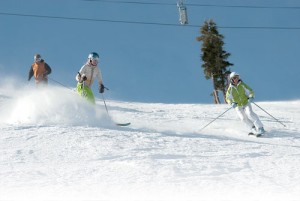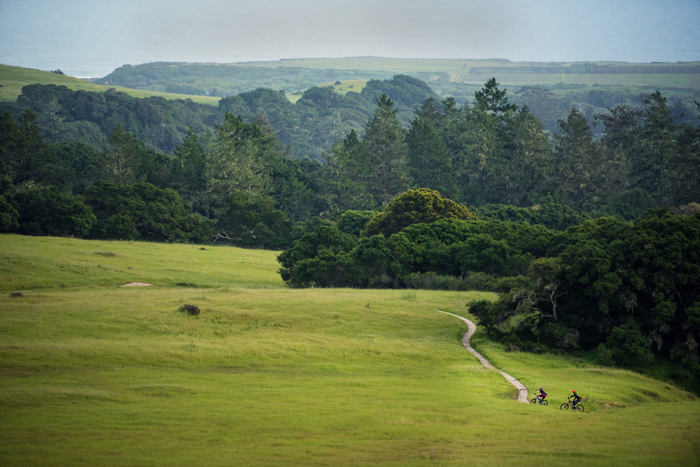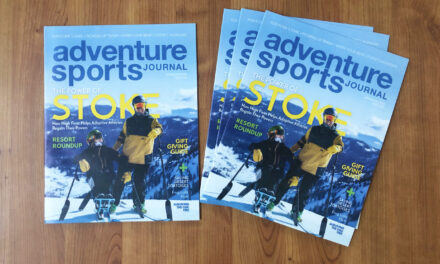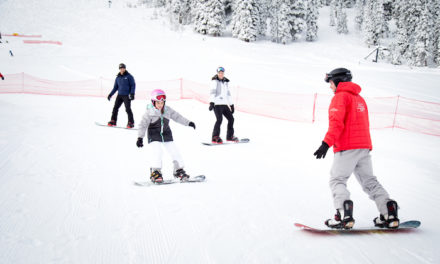- Tahoe’s Nevada Beach Tops the List of Hard-to-Book Campgrounds - 07/17/2024
- Cannabis Watershed Protection Program Cleans Up Illegal Grow Sites - 07/10/2024
- French Fire - 07/05/2024
 Alpine Meadow’s freeheel team one of the few in the nation to teach kids to rip on telemark gear
Alpine Meadow’s freeheel team one of the few in the nation to teach kids to rip on telemark gear
By Pete Gauvin • Photos by Kevin Klein
Telemark skiing is an addictive and challenging sport that most snow junkies discover only after years of alpine skiing and snowboarding. It might be the lure of the backcountry, the comfort of lighter weight gear, or the soulful, expressive style of the turn. Regardless, it’s largely an avocation of adults, twenty-somethings and up, often seasoned skiers and boarders that have plateaued and are looking for a fresh challenge.
Knee-dipping, heel-raising, box-sliding kids under 18? About as rare as a mountain lion sighting.
Except, that is, at Alpine Meadows, home to one of the few kids freeheel teams in the country. Under the tutelage of head coach and program brainchild Jason Layh, the Alpine Meadows’ program teaches kids to freeheel ski from the get go, not after the typical lengthy apprenticeship on alpine skis or snowboards.
Now entering its fifth season, the tele team has found its legs alongside traditional kids ski and snowboard teams as an established part of the Alpine Meadows Junior Development Program. From its beginning as an experimental seed in the 2005-06 season with eight kids, four boys and four girls, all still with the team, the program has gained notoriety and new students each year.
“After the first year every single kid was just thrilled and having the kids together out on the hill really turned heads,” says Layh, an affable Australian professional ski bum with a lengthy resume of credentials after many winters in both hemispheres as a ski partroller and instructor.
Sport, Not Race, Oriented
From early December to mid-April, the kids will spend about 50 days on snow with weekends and holidays combined. But unlike a lot of youth programs, the tele team (open to ages 10 to 18) does not focus on repetitive drills and running gates.
“We’re there primarily to have fun and explore the hill in ways that only telemarking can offer,” says Layh. “We don’t get bogged down with race training.”
“I was so happy it got going because if you want your kids to ski, and they aren’t into racing, this is perfect,” says Christine Hinkel, a Truckee resident whose 14-year-old daughter, Amory Harris, has been in the program since its inception. “They break out of the mold. It’s super fun, they get to be amazing skiers without the pressure of racing gates, and can still be competitive if they want to. It’s a big confidence builder to be able to do this sport and feel comfortable with it.”
“Jason is really great with the kids,” she adds. “He’s fun, professional, nurturing, understanding and gets the kids out there and loving it.”
Starting Small
Layh’s infectious enthusiasm has been the lifeblood of the program, but he started it out of his own self interest. After he discovered tele on his own in 2001, he was looking for a way he could stay in tele gear all season long rather than having to go back to stiff and restrictive alpine boots and bindings he wore as a freeride coach in the junior development program.
At the time, there were only a few other programs in the country that groomed kids to ski on freeheel gear: one in Mad River Glen, Vermont, an epicenter of the granola-head and flannel-clad telemark revival that trickled to life 30 years ago, and two at private schools in Colorado, Vail Mountain School and Colorado Rocky Mountain School. Recently, a couple new youth tele programs have also started in Utah, Layh says.
“We’re going to see the same explosion in freeheel skiing talent in another four to five years that we’ve been seeing in snowboarding and skiing,” Layh predicts. “Kids are doing stuff now I wouldn’t ever imagined doing.”
In the program’s second year, Layh was able to bring another eight kids on board, and add another coach, Chummy Prestowitz of Truckee.
“The team has been a life changing experience for me,” says Hannah Fasiang of Carson City, Nevada, now entering her fourth season on the team. “Not only has the team drastically improved my confidence in my skiing abilities, but I have also met some awesome new friends.”
In the first year of the program, kids develop basic skills on groomed terrain. In the second year, they’re introduced to riding off-piste and taught about all-mountain safety and terrain choice. In the third year, they learn advanced telemark and freeride skills, receive Level 1 avalanche training, and focus on skiing the entire mountain in all conditions. Further development is offered in park and pipe skiing, avalanche awareness, backcountry riding and freeskiing competitions.
“Most other skiers have taught themselves to tele and the learning curve is very slow,” Layh says. With the structured program, “the kids learn really quickly. It’s forced us to get better, too, otherwise the kids would soon surpass us.”
Last year at age 14, Fasiang was one of three team members to compete in their first national-level competition, the freeheel extreme championships in Crested Butte, Colorado.
“For me the experience has been both nerve-wracking and extremely fun,” she says. “Through the comps, I have met some amazing people from all different parts of the U.S. These experiences would not have happened if I wouldn’t have joined the team. The relationship I have with the coaches and other teammates does not end at the end of ski season, but continues throughout the year. The coaches are not only great at their job, they are also amazing friends and mentors.”
While the potential for injury exists, Layh believes there are fewer season-ending injuries with tele than with alpine skiing and snowboarding. Tele is more taxing on the muscles, but it’s easier on the joints, he says. That’s why he emphasizes that the kids get extra rest and they begin every day with stretching. So far, they’ve had no serious injuries.
The Gear Challenge
Age 10 is the lower limit for the kids tele program for some key reasons.
“Telemark skiing is the hardest of the snowsport disciplines,” Layh says. Kids needs to have some mental maturity and kinesthetic awareness to pick it up, not to mention strength. But more fundamental is the simple fact that most ski companies do not make freeheel gear that will fit small kids.
Indeed, finding affordable gear in sizes to keep fast growing kids in skis and boots has been one of the program’s biggest challenges. Justin Singer, a rep for Karhu skis, and Mike Schwartz, the owner of The BackCountry store in Truckee, were instrumental in providing equipment at discount rates to get the program off the ground.
“The first year we were able to get all the kids on boots, skis and bindings for $150 each,” Layh says.
Keeping outfitting costs low has been key in keeping parents on board and the program afloat, he stresses.
Last year, due to the skidding economy, every single team in Alpine’s Junior Development Program lost kids, except for the tele team, which picked up another four kids.
The bigger the program gets the easier it is to get gear from companies. And as their fleet of skis and boots grows, the gear can be handed down and resold from student to student, season to season. Layh also maintains a hotline connection to second-hand consignment shops, such as the Sports Exchange in Truckee and 9 Lives in Tahoe City, to alert him whenever junior-sized gear, often women’s gear, comes in.
This year, Layh hopes to have 25-30 kids in the program and add another coach, professional freeheeler Lorenzo Worster.
“We started forming a neat little community,” says Layh. And it’s growing with every genuflecting kid proving that kids can tele too.
For more information on the kids tele program, visit www.tahoefreeheel.com or Alpine Meadows’s website, www.skialpine.com. The program costs $1375 and includes a season pass.













